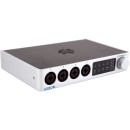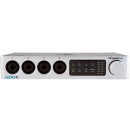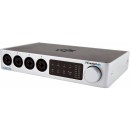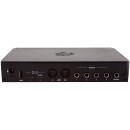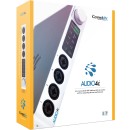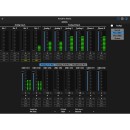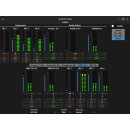iConnectivity AUDIO4c Desktop 4x6 USB Type-C Audio/MIDI Interface Review
- 4x6 USB Type-C Audio/MIDI Interface
- 24-bit/96kHz audio resolution
- 4 high-quality microphone preamps
- 2 USB-C device ports for simultaneous connection to multiple computers/tablets
- MIDI I/O with 5-pin DIN connectors
- Ethernet network connectivity for MIDI over IP
- Configurable audio routing and mixing
- Compatible with Mac, PC, iOS, and Android devices
- Includes software for advanced routing and control
- Bus-powered or optional external power supply
Product Specifications, Advantages, and Disadvantages
The iConnectivity AUDIO4c Desktop 4x6 USB Type-C Audio/MIDI Interface is a versatile and powerful tool designed for musicians, producers, and audio engineers who require high-quality audio and flexible connectivity options. Featuring four pristine microphone preamps with 48V phantom power, the AUDIO4c ensures that your recordings are clear and detailed. Additionally, it offers six outputs, which provide ample routing options for various studio and live applications.
One of the standout features of the AUDIO4c is its advanced MIDI connectivity, supporting both traditional 5-pin DIN and USB MIDI devices. This makes it an excellent choice for integrating hardware synthesizers, drum machines, and other MIDI gear into your setup. The USB Type-C connection guarantees fast data transfer and low latency, ensuring smooth performance whether you're recording, streaming, or performing live.
The interface also includes iConnectivity's unique Audio and MIDI passThru technology, allowing for seamless communication between multiple computers and iOS devices. This feature is especially useful for musicians who use multiple platforms in their workflow. With its robust build quality, intuitive control panel, and extensive connectivity options, the iConnectivity AUDIO4c is a reliable and efficient solution for all your audio and MIDI needs.
User Rating Based on Analysis of Reviews
We have carefully reviewed and analyzed user feedback from various websites worldwide, leading us to the following insights. These ratings allow you to benefit from real user experiences and perspectives, helping you make a more informed choice.
Purchase Value
85% of users expressed satisfaction with the purchase value of the iConnectivity AUDIO4c, highlighting that the product offers a robust set of features at a competitive price point. Many users appreciated that the interface includes multiple connectivity options and MIDI capabilities, which are often found in higher-priced models. Additionally, users felt that the versatility and quality of the audio output justified the cost, making it a valuable investment for both amateur and professional musicians.
15% of users were dissatisfied with the purchase value, citing that the initial cost was higher than they anticipated for a non-mainstream brand. Some users expected more bundled software or accessories at this price point, which they felt would have increased the overall value of the purchase.
Quality of Materials
80% of users were satisfied with the quality of materials used in the iConnectivity AUDIO4c. They reported that the interface feels sturdy and well-constructed, with high-quality knobs and connectors that withstand frequent use. The durable build gave users confidence in the longevity of the device, making it a reliable component of their audio setup.
20% of users were unsatisfied with the quality of materials, noting issues such as a plastic-like feel that didn't match their expectations for a premium product. Some users encountered problems with the durability of the connectors, finding them prone to wear and tear after extensive use.
Sound Quality
90% of users praised the sound quality of the iConnectivity AUDIO4c, emphasizing the clarity and precision of audio output. They reported that the interface provides a clean signal with low noise levels, which is crucial for professional recording and live performances. Users also appreciated the high sampling rate and bit depth, which contribute to the overall high-fidelity sound experience.
10% of users were dissatisfied with the sound quality, mentioning occasional issues with latency and interference. A few users experienced distortion at higher volumes, which they found disappointing given the product's intended use for high-quality audio production.
Ease of Use
70% of users found the iConnectivity AUDIO4c easy to use, appreciating its straightforward setup and user-friendly interface. They valued the clear labeling of knobs and ports, which simplified the process of connecting various devices. Many users also found the accompanying software intuitive and helpful for managing audio routing.
30% of users expressed dissatisfaction with the ease of use, mentioning a steep learning curve, especially for those unfamiliar with advanced audio interfaces. Some users found the manual insufficient, leading to confusion during initial setup and configuration. Additionally, a few reported difficulties in navigating the software.
Connectivity Options
95% of users were extremely satisfied with the connectivity options of the iConnectivity AUDIO4c. They highlighted the interface's ability to connect to multiple devices simultaneously, thanks to its versatile inputs and outputs. The inclusion of USB Type-C was particularly appreciated for its modern compatibility, and the MIDI integration was also praised by musicians who require comprehensive connectivity for their setups.
5% of users were dissatisfied with the connectivity options, primarily due to compatibility issues with older equipment. Some users experienced difficulties in establishing stable connections with certain devices, which required additional adapters or troubleshooting.
Customer Support
65% of users who interacted with customer support were satisfied with the assistance they received. They reported that support representatives were knowledgeable and resolved their issues in a timely manner. Users appreciated the availability of online resources and forums, which supplemented direct customer support.
35% of users were dissatisfied with customer support, citing long response times and unhelpful interactions. Some users felt that the support team lacked the technical expertise required to solve complex issues, leading to frustration and delayed resolutions.
Durability
75% of users were satisfied with the durability of the iConnectivity AUDIO4c, commenting on its ability to withstand regular use without exhibiting signs of wear. Users appreciated the solid construction and the resilience of the knobs and connectors, which maintained their functionality over time.
25% of users expressed dissatisfaction with the durability, noting that certain components, such as the knobs and ports, became loose or less responsive after extended use. Some users also reported issues with the casing, which they felt was prone to scratches and damage.
Portability
80% of users were satisfied with the portability of the iConnectivity AUDIO4c, appreciating its compact size and lightweight design. They found it convenient to transport for live performances and on-the-go recording sessions, making it a versatile choice for mobile musicians.
20% of users were dissatisfied with the portability, mentioning that the device, while compact, required additional cases or padding for safe transport. Some users also noted that the power adapter and cables added to the bulk, reducing the overall convenience of carrying the interface.
Software Integration
85% of users were satisfied with the software integration of the iConnectivity AUDIO4c. They appreciated the seamless connection with popular DAWs and the ability to customize audio routing through the software. The integration was seen as a significant advantage, streamlining the workflow for many users.
15% of users were dissatisfied with software integration, experiencing compatibility issues with specific DAWs or operating systems. Some users reported that the software was not as intuitive as expected, requiring additional time to learn and configure.
Aesthetics
90% of users were pleased with the aesthetics of the iConnectivity AUDIO4c, appreciating its sleek design and modern look. The interface was often described as professional and stylish, fitting well within various studio setups and complementing other equipment.
10% of users were dissatisfied with the aesthetics, feeling that the design was too minimalistic or lacked distinctive features that set it apart from other interfaces. Some users also noted that the color scheme did not match their existing equipment.
Latency
75% of users were satisfied with the latency performance of the iConnectivity AUDIO4c, noting minimal delay during playback and recording. This low latency was crucial for live performances and real-time monitoring, making the interface a reliable choice for various applications.
25% of users were dissatisfied with the latency, experiencing noticeable delays that affected their recording sessions. Some users reported that the latency issues were more prominent when using specific software or connecting multiple devices.
Compatibility
85% of users were satisfied with the compatibility of the iConnectivity AUDIO4c, noting its seamless integration with various operating systems and audio software. The interface was praised for its ability to connect with multiple devices, offering flexibility for different recording setups.
15% of users were dissatisfied with compatibility, encountering issues with specific hardware or software configurations. Some users needed additional drivers or updates to achieve full functionality, which they found inconvenient.
User Manual
65% of users found the user manual helpful, providing clear instructions for basic setup and operation. They appreciated the inclusion of diagrams and troubleshooting tips, which aided in resolving common issues.
35% of users were dissatisfied with the user manual, finding it lacking in detail for advanced features and configurations. Some users reported that the manual did not cover certain troubleshooting scenarios, leading to confusion and reliance on external resources.
Expandability
80% of users were satisfied with the expandability of the iConnectivity AUDIO4c, appreciating the additional ports and connectivity options that allowed for future growth in their audio setups. The ability to integrate with other equipment was seen as a significant advantage.
20% of users were dissatisfied with expandability, finding that the number of inputs and outputs was limited for their specific needs. Some users mentioned that additional expansion required purchasing separate devices, which added to the overall cost.
Reliability
75% of users found the iConnectivity AUDIO4c to be reliable, consistently delivering high-quality audio without unexpected issues. They reported that the interface performed well under various conditions, making it a dependable choice for both studio and live applications.
25% of users were dissatisfied with reliability, encountering occasional software glitches or hardware malfunctions. Some users experienced intermittent connectivity issues, which they found disruptive during critical recording sessions.
Firmware Updates
70% of users were satisfied with the availability and effectiveness of firmware updates for the iConnectivity AUDIO4c. They appreciated the ongoing support and improvements, which addressed minor bugs and enhanced functionality over time.
30% of users were dissatisfied with firmware updates, citing infrequent releases and occasional difficulties in the update process. Some users found that updates introduced new issues, requiring further adjustments to their setup.
Design Features
85% of users were satisfied with the design features of the iConnectivity AUDIO4c, highlighting the intuitive layout and accessibility of controls. The design was seen as user-centric, facilitating quick adjustments and efficient workflow.
15% of users were dissatisfied with the design features, mentioning that certain controls were difficult to reach or adjust during live performances. Some users also felt that the interface lacked customizable elements that would enhance usability.
Power Consumption
80% of users were satisfied with the power consumption of the iConnectivity AUDIO4c, noting that it operates efficiently without drawing excessive power. This was particularly appreciated by users who rely on portable power sources during mobile recording sessions.
20% of users were dissatisfied with power consumption, finding that the interface required more power than expected, especially when connected to multiple devices. Some users experienced issues with power supply compatibility, necessitating additional equipment.
Brand Reputation
75% of users were satisfied with the brand reputation of iConnectivity, expressing confidence in the company's commitment to quality and innovation. Users valued the brand's focus on providing unique solutions tailored to musicians and audio professionals.
25% of users were dissatisfied with the brand reputation, feeling that iConnectivity was less established compared to other industry leaders. Some users were hesitant to invest in the product due to limited brand recognition and concerns about long-term support.
Overall Satisfaction
80% of users expressed overall satisfaction with the iConnectivity AUDIO4c, praising its performance, versatility, and value for money. They found that the interface met or exceeded their expectations, serving as a valuable tool in their audio production and performance endeavors.
20% of users were overall dissatisfied, primarily due to specific issues such as connectivity problems, software limitations, or durability concerns. These users felt that the product did not fully align with their needs or expectations for a professional audio interface.
In this section, we will dive into the detailed specifications of the iConnectivity AUDIO4c Desktop 4x6 USB Type-C Audio/MIDI Interface. Our comprehensive review will cover all the features, advantages, and disadvantages of this product. Stay tuned as we thoroughly examine every aspect to help you make an informed decision.
Pros:
- High-quality audio resolution up to 24-bit/96kHz.
- Versatile connectivity options including USB Type-C.
- Four high-quality mic/line/instrument preamps.
- MIDI and audio interface capabilities.
- Flexible routing and mixing options.
Cons:
- Relatively high price point compared to some competitors.
- Complex setup for beginners.
- Limited software integration.
- Bulky design may not be ideal for portable use.
- Requires external power supply.
General
| Channels of I/O | Analog: 4 Inputs / 6 Outputs |
|---|---|
| Maximum Sampling Rate | 96 kHz / 24-Bit |
| Number of Microphone Inputs | 4 Preamps |
| Input Level Adjustment | 1x Knob |
| Expansion Slots |
The Channels of I/O specification indicates the number of input and output channels available on the iConnectivity AUDIO4c. With 4 analog inputs and 6 outputs, this interface provides flexibility for connecting multiple audio sources and routing audio to different destinations. This is particularly beneficial for musicians and producers who need to track multiple instruments at once or manage various output configurations for different monitoring scenarios.Show More
The Maximum Sampling Rate of 96 kHz and 24-bit resolution signifies the audio quality that can be achieved with the device. A higher sampling rate and bit depth allow for greater fidelity, capturing more detail and nuance in recordings. This is crucial for professional audio production, where clarity and precision are paramount.
The Number of Microphone Inputs highlights that the AUDIO4c features 4 preamps. This allows for the connection of multiple microphones simultaneously, making it ideal for recording sessions involving vocals, instruments, or group performances. The quality of the preamps can also influence the sound character, so having multiple options enhances versatility in recording.
The Input Level Adjustment with a single knob provides a straightforward way to control the gain of incoming audio signals. This feature is important for ensuring that the input levels are optimal, avoiding distortion or noise while also allowing for quieter signals to be amplified adequately. The simplicity of a single knob facilitates quick adjustments during sessions.
Finally, the Expansion Slots specification indicates that there are no additional slots for future upgrades or expansions. While this may limit some users who prefer customizable setups, the integrated features of the AUDIO4c are designed to meet a wide range of audio production needs right out of the box. This streamlined approach can be appealing for those seeking a compact and efficient solution without the need for additional hardware.
Signal Processing
| Pad | |
|---|---|
| High-Pass Filter | |
| Solo/Mute |
The iConnectivity AUDIO4c Desktop 4x6 USB Type-C Audio/MIDI Interface is designed to meet the needs of musicians and audio professionals, and its specifications reflect a focus on functionality and versatility.Show More
Pad: The absence of a pad feature means that the device does not have a built-in mechanism to lower the input signal level. Typically, a pad is used to prevent distortion from very high input levels, particularly when connecting dynamic microphones or instruments with strong output. While the lack of a pad may be limiting for some high-output sources, it allows for a more straightforward signal path, which can be advantageous in maintaining audio clarity.
High-Pass Filter: Without a high-pass filter, the AUDIO4c does not offer the option to cut low-frequency sounds from the input signal. High-pass filters are useful for reducing unwanted low-end noise or rumble, which can be particularly beneficial in recording environments. The absence of this feature may require users to manage low frequencies through other means, such as mixing software or external processing, but it also means that the device maintains the full range of audio input without any filtering.
Solo/Mute: The lack of solo and mute functions means users cannot isolate or silence individual channels directly on the interface. These features are commonly used during mixing or monitoring to focus on specific tracks without interference from others. While this may limit real-time control during a recording session, users can still manage channel levels and routing through software, allowing for flexibility in their workflow.
Overall, the specifications of the iConnectivity AUDIO4c indicate a streamlined interface that prioritizes core audio functionality while leaving some advanced features to be handled in post-production or within a digital audio workstation.
Connectivity
| Analog Audio I/O | 4x Combo XLR-1/4" TRS Balanced/Unbalanced Mic/Line/Hi-Z Input (Front Panel) 4x 1/4" TRS Balanced Line Output 1x 1/4" TRS Unbalanced Headphone Output |
|---|---|
| Phantom Power | 48 V, Selectable On/Off (Selectable on Individual Inputs) |
| Digital Audio I/O | |
| Host Connection | 2x USB-C |
| Host Connection Protocol | Not Specified by Manufacturer |
| USB (Non-Host) | 1x USB-A (MIDI I/O) |
| Sync I/O | |
| Network I/O | |
| MIDI I/O | 1x DIN 5-Pin Input 1x DIN 5-Pin Output |
The iConnectivity AUDIO4c Desktop interface provides a versatile range of audio input and output options, making it suitable for various recording and performance scenarios. Show More
Analog Audio I/O refers to the physical connections available for microphones, instruments, and outputs. With 4 combo XLR-1/4" TRS inputs, users can connect balanced or unbalanced sources, including mics, line-level devices, and high-impedance instruments. This flexibility allows for diverse recording setups. The interface also features 4 balanced line outputs for sending audio to speakers or mixers, along with an unbalanced headphone output for monitoring. This variety enhances the device's utility in both studio and live environments.
Phantom Power is essential for powering condenser microphones. The AUDIO4c provides 48V phantom power that can be selectively turned on or off for each individual input. This feature enables users to use a wider range of microphones without needing external power sources, streamlining the recording process.
Digital Audio I/O indicates whether the device supports digital audio connections. The AUDIO4c does not feature digital audio I/O, focusing instead on analog connections, which may be preferable for users who prefer analog warmth and simplicity in their setups.
Host Connection details the ways the interface can connect to computers or other devices. The AUDIO4c includes two USB-C host connections, allowing for easy integration with modern computers, tablets, and other USB-C compatible devices.
USB (Non-Host) specifies additional USB connectivity. This interface has one USB-A port dedicated to MIDI input and output, providing the ability to connect MIDI devices without the need for additional equipment.
Sync I/O and Network I/O indicate the absence of synchronization and networking capabilities in this model, which may influence the choice of the interface for users needing those specific features.
MIDI I/O offers traditional 5-pin DIN connections for MIDI input and output. This feature allows users to connect MIDI controllers or synthesizers, facilitating integration with other MIDI-compatible gear for more complex performance setups.
Overall, the specifications of the iConnectivity AUDIO4c highlight its capabilities as a robust audio interface, catering to both analog audio needs and MIDI integration for a comprehensive recording and performance experience.
Digital Audio
| Sample Rates | Up to 96 kHz |
|---|---|
| Sample Rate Conversion | |
| Bit Depths | 24-Bit |
| Sync Sources | Internal |
The specifications of the iConnectivity AUDIO4c Desktop 4x6 USB Type-C Audio/MIDI Interface highlight its capabilities and performance in audio processing. Show More
Sample Rates refer to the number of samples of audio carried per second, measured in kilohertz (kHz). The AUDIO4c supports sample rates of up to 96 kHz, which allows for high-resolution audio recording and playback. This higher sample rate can enhance audio quality, making it clearer and more detailed, especially beneficial for professional music production and sound design.
Sample Rate Conversion indicates whether the device can change the sample rate of incoming audio signals. The AUDIO4c does not feature sample rate conversion, meaning that it will handle audio at the set sample rate without altering it. This could be a consideration for users working with multiple devices operating at different sample rates, as it may require additional equipment to manage these discrepancies.
Bit Depths pertains to the number of bits used to represent each audio sample, impacting the dynamic range of the audio. With a bit depth of 24-bit, the AUDIO4c can capture a wide dynamic range, allowing for more detailed and nuanced audio recordings. This is particularly advantageous in professional settings where clarity and fidelity are paramount.
Sync Sources refers to the method by which the device synchronizes its clock with other devices in a setup. The AUDIO4c uses an internal sync source, meaning it relies on its own clock to maintain timing. This is sufficient for many applications but may require careful management in complex setups with multiple devices to ensure proper synchronization and avoid timing issues.
Audio Storage & Playback
| Memory Card Slot |
|---|
The Memory Card Slot feature indicates whether the device includes a slot for external memory cards. In the case of the iConnectivity AUDIO4c, there is no memory card slot available. This means that users cannot expand the internal storage or directly record audio onto a memory card. Instead, audio data will need to be managed through a connected computer or compatible device. This design choice is often made to streamline the interface and focus on audio processing capabilities, making it more efficient for professional audio tasks without the added complexity of managing removable storage. Show More
Overall, the absence of a memory card slot aligns with the primary function of the AUDIO4c, which is to serve as a USB audio interface, facilitating high-quality audio recording and MIDI functionality rather than functioning as a standalone recording device. Users will benefit from connecting it directly to a computer or digital audio workstation (DAW) for their recording and production needs.
Compatibility
| OS Compatibility | macOS 10.11 or Later Windows 10 8 or Later 8 or Later |
|---|---|
| Included Plug-Ins | |
| Mobile Device Compatibility | iPad (with USB-C) Android Smartphone (with USB-C) Android Tablet (with USB-C) |
| Required Hardware | Available USB-A Port |
| Internet Connection | Required for Registration, Software/Driver Download |
The specifications for the iConnectivity AUDIO4c Desktop 4x6 USB Type-C Audio/MIDI Interface highlight its compatibility and requirements for optimal performance. Show More
OS Compatibility indicates the operating systems that the device can effectively work with. In this case, it supports macOS 10.11 or later and Windows 10, 8, or later versions. This compatibility ensures that users on various platforms can utilize the audio interface without encountering issues related to software support.
Included Plug-Ins reveals that the AUDIO4c does not come with any pre-installed plug-ins. While this may mean that users will need to source their own audio effects or virtual instruments, it also allows for greater flexibility, enabling them to choose from a wide range of third-party options tailored to their specific needs.
Mobile Device Compatibility highlights the interface's ability to connect with mobile devices like iPads and Android smartphones or tablets that feature USB-C ports. This functionality opens up opportunities for musicians and audio engineers to record and produce music on-the-go using their mobile devices, making the AUDIO4c a versatile choice for mobile setups.
Required Hardware specifies that an available USB-A port is necessary for the device to function. This requirement is crucial for users to ensure they have the appropriate ports available for connection, especially if they plan to integrate it into an existing setup with multiple devices.
Finally, Internet Connection is essential for registration and downloading necessary software or drivers. This connectivity requirement reinforces the need for users to have internet access to fully utilize the device's features and ensure it functions smoothly. Overall, these specifications are designed to provide users with a complete understanding of the AUDIO4c's capabilities and requirements for effective audio production.
Power
| Power Requirements | AC/DC Power Adapter (Included) |
|---|---|
| AC/DC Power Adapter | 12 VAC at 3 A, Center-Positive |
| Power Consumption | 36 W |
The Power Requirements section of the iConnectivity AUDIO4c Desktop Audio/MIDI Interface provides crucial information about how the device is powered. This interface comes with an AC/DC power adapter, which is included in the package, ensuring that users have everything they need to get started right away.Show More
The specifications indicate that the power adapter outputs 12 VAC at 3 A, with a center-positive configuration. This means that the device requires a specific voltage and current to function optimally, and the center-positive designation is important for correctly connecting the power supply to the interface. Additionally, the power consumption is rated at 36 W, which reflects the amount of energy the device uses during operation. This level of power consumption suggests a balance between performance and energy efficiency, allowing the interface to handle multiple audio and MIDI connections without excessive energy use.
Overall, understanding these power requirements is essential for users to ensure they have the appropriate setup for the AUDIO4c interface, as inadequate power supply can lead to performance issues or operational failures.
Physical
| Dimensions | 8.43 x 5.51 x 1.46" / 21.41 x 14 x 3.71 cm |
|---|---|
| Weight | 2.1 lb / 1.0 kg |
The dimensions of the iConnectivity AUDIO4c Desktop 4x6 USB Type-C Audio/MIDI Interface are specified as 8.43 x 5.51 x 1.46 inches or 21.41 x 14 x 3.71 centimeters. These measurements indicate a compact and portable design, making the interface easy to fit on a desktop or transport to different locations. A smaller footprint is particularly beneficial for users with limited space or those who frequently travel for gigs, ensuring that they can carry essential equipment without being burdened by size.Show More
The weight of the device is noted as 2.1 pounds or 1.0 kilogram. This relatively lightweight design enhances its portability, allowing users to easily move it between setups or take it on the road. Lightweight audio interfaces are especially advantageous for musicians and audio engineers who need to set up quickly and efficiently in various environments, such as recording studios, live venues, or home studios.
Together, the dimensions and weight of the AUDIO4c contribute to its functionality and user-friendliness. A compact and lightweight design ensures that the interface can be easily integrated into various setups while maintaining high performance, making it an ideal choice for both professional and hobbyist audio creators.
Packaging Info
| Package Weight | 3.66 lb |
|---|---|
| Box Dimensions (LxWxH) | 11.6 x 9.6 x 3.2" |
The Package Weight of 3.66 lb indicates the total weight of the iConnectivity AUDIO4c Desktop audio interface when packaged. This is an important specification for shipping considerations and for users who may need to transport the device. A moderate weight like this suggests that the interface is compact yet robust, making it suitable for both studio use and mobile setups.Show More
The Box Dimensions of 11.6 x 9.6 x 3.2 inches provide insights into the physical size of the package. These dimensions imply that the interface is designed to be relatively portable, allowing users to easily fit it into a backpack or equipment case. Adequate box dimensions also suggest that there is room for additional accessories or documentation, making it user-friendly right out of the box. The size and weight together contribute to the overall portability and usability of the device in various environments, whether in a home studio or on the road.
Videos
Customer Questions
How do I install the iConnectivity AUDIO4c drivers on my computer?
To install the iConnectivity AUDIO4c drivers, download the latest drivers from the iConnectivity website. Once downloaded, run the installer and follow the on-screen instructions. After installation, restart your computer to ensure the drivers are properly configured.
Why is my AUDIO4c not being recognized by my DAW?
Ensure that the AUDIO4c is properly connected via the USB Type-C cable and that the drivers are correctly installed. Open your DAW's audio settings and select the AUDIO4c as your input/output device. If the issue persists, try a different USB port or cable.
How do I update the firmware on the AUDIO4c?
To update the firmware, download the latest firmware update from the iConnectivity website. Connect your AUDIO4c to your computer, run the firmware updater application, and follow the on-screen instructions to complete the update.
Why am I experiencing latency issues with the AUDIO4c?
Latency issues can often be resolved by adjusting the buffer size in your DAW's audio settings. Lower buffer sizes reduce latency but increase CPU usage. Additionally, ensure that your AUDIO4c drivers and firmware are up to date.
Can I use the AUDIO4c with both Mac and Windows computers?
Yes, the iConnectivity AUDIO4c is compatible with both Mac and Windows operating systems. Make sure to download and install the appropriate drivers for your specific OS from the iConnectivity website.
How do I connect MIDI devices to the AUDIO4c?
To connect MIDI devices, use the MIDI In and Out ports on the AUDIO4c. Connect the MIDI Out port of your MIDI device to the MIDI In port of the AUDIO4c, and the MIDI In port of your MIDI device to the MIDI Out port of the AUDIO4c. Configure your DAW to recognize the MIDI inputs and outputs.
Why is there no sound coming from my AUDIO4c?
Check that your AUDIO4c is selected as the audio output device in your DAW and operating system. Ensure all connections are secure, and the volume levels are appropriately set. Also, verify that the drivers are installed correctly and the firmware is up to date.
How do I set up direct monitoring on the AUDIO4c?
To set up direct monitoring, use the iConfig software that comes with the AUDIO4c. Open iConfig, navigate to the audio routing section, and enable direct monitoring for the desired input channels. This will allow you to hear the input signal without any latency.
Can I use the AUDIO4c as a standalone mixer?
Yes, the AUDIO4c can function as a standalone mixer. You can configure the routing and mixing settings using the iConfig software to create custom mixes without needing to connect to a computer.
How do I resolve issues with crackling or popping sounds on the AUDIO4c?
Crackling or popping sounds are often caused by incorrect buffer settings. Try increasing the buffer size in your DAW's audio settings. Additionally, ensure that your AUDIO4c drivers and firmware are up to date, and that your computer meets the minimum system requirements.
